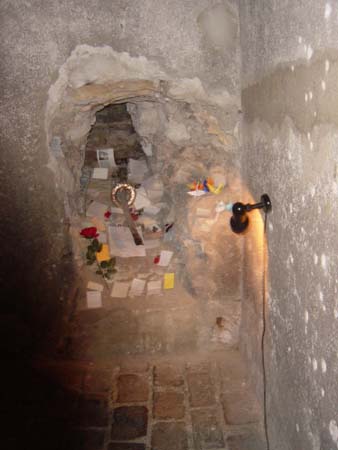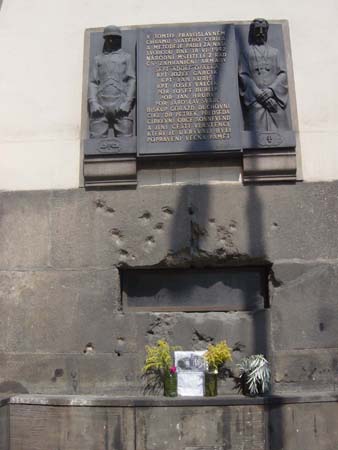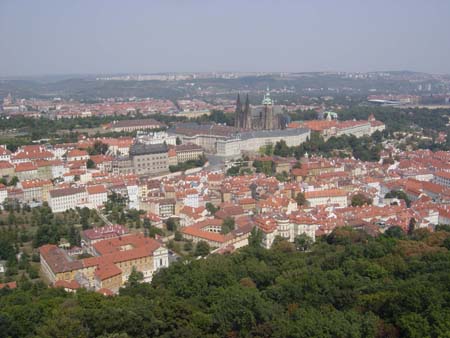Wednesday, August 13
Steve: This morning we went to the "National Memorial to the Heroes of the Heydrich Terror." The memorial is housed in an Orthodox Cathedral where seven Czech paratroopers involved in the assassination of Reinhard Heydrich hid from the Nazis in 1942. Heydrich was one of the most brutal and feared men in the SS, and was based in Prague responsible for the Germanization of Czechoslovakia. With the support of the British, a team of Czech resistors trained in Scotland and was dropped into Nazi-controlled Czech territory in December of 1941. In May 1942, as Heydrich was being driven around a corner on a Prague street, the assassins ambushed his car. The first assassin's gun jammed, but as Heydrich ordered his driver to stop and stood in an attempt to shoot the first man, the second paratrooper threw a bomb at the car. Heydrich was expected to recover from his injuries, but died of blood poisoning - pieces of the material from the seat in his car had entered his become lodged in his body as a result of the explosion.
A massive search was conducted by the Nazis, but they were unable to find
the paratroopers for three weeks. Eventually, the paratroopers were betrayed
by one of their own, and the Nazis stormed the cathedral. The 7 paratroopers
successfully fought off the 800 SS soldiers for several hours, before finally
succumbing and committing suicide (the Nazis had wanted them captured alive).

In the cathedral, we were able to see where the paratroopers hid, and where
they had tried in desperation to dig an escape tunnel into the sewer (seen
in the picture on the left). Outside the cathedral, there's a monument to
the paratroopers, and the marks from the bullets are still  clearly
visible on the wall (shown here on the right). We also watched a video that
re-enacted the assassination, and learned that there's an American movie called
"Operation Daybreak" that tells the story (we'll definitely watch
this movie when we return…).
clearly
visible on the wall (shown here on the right). We also watched a video that
re-enacted the assassination, and learned that there's an American movie called
"Operation Daybreak" that tells the story (we'll definitely watch
this movie when we return…).
Heydrich's assassination led the Nazis to totally destroy the Czech town of Lidice, and to kill almost all of its inhabitants.
The Memorial is very effective in communicating the significance of this
event in Czechoslovakia's history. Heydrich's murder and the resulting atrocities
committed by the Nazis helped raise international attention to what was happening
in Europe during the early 1940's. Seeing the actual bullet marks, the spot
where the paratroopers tried to dig for freedom, and the stairs where the
Nazis stormed the cathedral all helped bring this to life for us today.
After visiting the cathedral, we walked across the Vlatava and rode the funicular railway to the top of Petrin Hill where we climbed the tower and got a marvelous view of Prague. We've had a wonderful week here, and it was great to see the entire city from this vantage point one last time before we leave.
For dinner, we had a wonderful opportunity to spend time with Michal, who is a friend of a friend. We had just received an e-mail from Michal yesterday, and immediately accepted his offer to get together before we left Prague. It was great to hear his perspective about life in Prague, both today and in years past. Michal also shared much about daily life in Prague, and how different things are during the off-season when all the tourists leave (hard to imagine now, with all the people in the streets!). Michal has lived in Prague his whole life, and said he could never remember a stretch of summer as hot and dry as this one has been. We told him that we're getting used to the heat, but are looking forward to a reprieve in St. Petersburg.
We're finding that getting together with people like Michal is one of the highlights of our travel. We definitely plan on continuing to do this as our adventures continue.
Paula: Katie and I had a nice afternoon without "the boys." We decided to shop for some clothes for Katie as her birthday is just a couple days away. It took us some time to figure out where the dressing room was and to determine size and pricing but we eventually caught on. It was fun to be doing a "normal activity" and Katie is looking forward to wearing some of her new outfits-we have already gotten tired of the clothing we brought from home! We also enjoyed a quiet lunch in a beautiful café before searching out a small art gallery displaying the work of a Czech artist who is a "new impressionist." Unfortunately, the gallery was closed but we viewed his work in the window and found it very interesting.
Distance Walked: 2.86 miles (Michal took a special interest in learning about why we're logging our walking miles - we told him that we weren't exactly sure why we're doing this! We decided afterwards that he probably thinks that we're very anal…who, us?)
David: The Terezin Concentration Camp
The Terezin concentration camp, located in northern Czech Republic, was a very unique camp. It was an artificial town set up as propaganda to fool the Red Cross about its real identity. Before World War II, Terezin was just a regular town, when the Nazis invaded and kicked all the Czechs out of the town. They then created it into a ghetto for the Jews, who were constantly tortured and killed. The Nazis also made a prison in the ghetto, called the Small Fortress. We visited this fortress, along with the town and ghetto museum.
The town of Terezin is old and rundown, with deserted streets and sidewalks. When the Jews lived there, it was very depressing and full of despair. Today, seems to be carrying the burden of its past. The Small Fortress is not far from the town, but still seems to be in the middle of nowhere. There aren't any stores or buildings nearby, just the concentration camp and its towering stone walls. An empty moat surrounds the camp along with the words in the gate, "work sets one free." This statement was just propaganda, and was a Nazi motto. The camp had about 30-40 cells - some were mass cells and some were isolation cells. Each mass cell was for a different group of prisoners. There could be 50-100 people in each cell, with one disgusting toilet and one sink. The Jewish cell could fit about five people comfortably, but the Nazis stuffed sixty in here. It also had an execution wall, where people were shot by a soldier four meters away from them. The soldiers had target practice, and made the prisoners run back and forth while they shot at you. Some prisoners managed to escape and they told people about the camps, but no one would believe them. The officers and soldiers lived comfortably in the prison. There was a swimming pool and even a movie theater for the officers and their families.
The Jews in the ghetto also had very difficult living conditions. The town was rebuilt to fool the Red Cross about its secret identity. The Nazis made many changes to the town to make it look like a nice place for the Jews to live. They cleaned up the town, and made the Jews clean the streets, buildings, and even made them wash and dust everything in their barracks. A shaving room was even built in the fortress, but the sinks were not connected to any water pipes. The day of the visit, they served good food, had soccer matches, plays, and movies. Everyone was smiling and laughing, which they were forced to do. Right before the visit, they sent almost half of the Jews to Auschwitz, an extermination camp in Poland. The Jews, upon their arrival, were taken immediately off the train and told they were going to take showers. They undressed, and were brought into a room where they were gassed.
The Nazis planned the Red Cross' visit down to the last minute, and made everything perfect. To the Red Cross, this seemed like a wonderful place. They were told by the Nazis that it was always like this and that once you were here you stayed here and were never sent anywhere else. They called it a destination camp. They were also told that the whole town was exactly the same. Because of this, the Red Cross had no reason to search the fortress since it was supposedly the same. As a part of the Red Cross report, pictures were taken of smiling children who were gassed weeks after the pictures were taken. After the inspection had been a success, everything was changed back to normal, including their daily meals of coffee (breakfast and dinner) and hot water (supposedly vegetable soup) with a small portion of bread for lunch. The worst thing of all was that the Red Cross fell for it, and issued a great report on the ghetto which was completely false. This was a total success for the Nazis, which ensured the rest of the world that they were doing nothing wrong.
It was very interesting, but depressing, to learn about this unique concentration camp. I couldn't believe that it was an artificial town, and was set up to fool the Red Cross. It was unbelievable. The Nazis had to make so many changes, and the people had to cooperate too. I bet that if they knew what was going on then they would have acted differently and show what life in the ghetto was really like. It must have been strange for one day everything to be great, and the next so terrible. The Jews must have been so confused, but they didn't have time to think about it before they were gassed. Jews all over Europe, including from Terezin, were sent to Auschwitz to be gassed. We learned at the museum in the town that 20,000 Jews could be gassed in one day. Yes, one day. It is such a terrible thing to think about that I will say no more.
